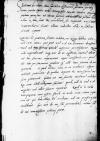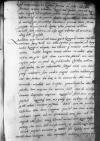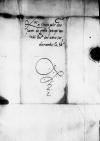Sentimus hic etiam illam civitatem dissensionibus fervere partimque novis partim sopitis malis interque alia haereseos strudere proptereaque pretium operae fore, ut illorum parvuli allidantur ad petram, dum adhuc in sinu sunt et correctionem sui recipiunt, ne, si inanimadversi(!) fiant, altius radicibus actis, in sublime ferant capu{n}t.
Quaesivi hic praeterea semotis arbitris ex ⌊regiis maiestatibus⌋, num aut iam nunc aut post Vestrae Reverendissimae Dominationis ex humanis decessum ⌊ducem⌋ ad bona ⌊episcopatus⌋ eiusdem aspirare permisissent. ⌊Quae⌋ mihi responderunt neque sese de eo cogitasse, tantum abest, ut hoc facinus imperarint. Quare verisimile est, quod ⌊ille⌋ tam per ⌊Masoviam⌋ gradiens, quam alibi hanc famam de suo sparserit. Si quid tamen novi in ea re oboriri aliisve rescisset, praesertim de quibus aequum et necessarium me scire putaverit, quaeso, ut me secreto certiorem reddat. Ego vero nihil reliquum faciam, quod vel in Vestrae Reverendissimae Dominationis negotiis vel aliis facere oporteat. Quod si in aula tum praesens non essem, facile in aula meos etiam reperire est, qui litteras illius bene occlusas ad me perferri tuto studebunt. Hoc autem de me sibi persuadeat, velim, quod de sui amantissimo polliceri potest.
Quid rerum novarum hic agatur, prorsus non video, nisi hoc fortasse novum videatur, quod domini spirituales poscente atque adeo urgente id necessitate publica receperunt sese onus belli Turcici, si et quando finibus ingruerit nostris, una nobiscum de omnibus suis proventibus levaturos, personis tamen illorum exceptis, ne sacrificalis dignitas usibus prophanis violetur. Decreti sunt praeterea ex aliis ⌊regni⌋ ordinibus alii exercitus aliaque belli praesidia.
Audimus vero ⌊Turcam⌋ sub aestatis tempora in ⌊Hungariam⌋ rursus expeditionem maturare iamque ⌊Buda⌋ XV milia equitum per ⌊Danubium⌋ ad depopulandas Hungariae reliquias tam ⌊Poloniae⌋ quam ⌊Moraviae⌋ conterminas mississe. Quibus ⌊Hungari⌋ tametsi obviam ire volunt, attamen misera illa gens iusti etiam exercitus formam vix iam explere potest, eo quod et seditionibus civilibus nullum ponit modum, et tot calamitatibus fatigati animi eius, haudquaquam constanter sese credere pugnae contra victores poterint, nisi fortasse dominus Deus in his animandis, illis vero terrendis mirabilis esse incipiat. Quandoquidem illius potentia tunc maxime sese exserere solet, cum de viribus humanis desperatur maxime. Quicquid tamen feret sors, temp[u]s proferet, quamquam iam vix quicquam spei melioris de ⌊illius gentis⌋ salute concipere possimus, etenim non ita pridem ⌊Ladislaus etiam More⌋ Hungarus quadam sua ⌊arce⌋ a ⌊Turcis⌋ violenter capta ad 20 centenaria auri fusi, ad 60 argenti etiam fusi unaque coronam auream olim regis Bosnae posteaque olim ducis dicti ercyk ⌊Lorincz⌋ de familia regum Bosnen[sium] oriundi, propriam novissime per ipsius ⌊Ladislai More⌋ antea vero dicti ⌊ducis⌋ ⌊coniugem⌋ illuc importatam multamque praeterea pecuniam
et omnifariae supellectilis vim una secum ipsa ⌊coniuge⌋ et l[iberis] in miseram captivitatem hostibus porrexit, ita illic urgen[tibus] sese fatis malum malo cumulatur indies.
Indicta sunt autem per ⌊caesaream maiestatem⌋ ⌊Spyrae⌋ ⌊comitia⌋. Faxit dominus Deus, ut tanti in ⌊Turcam⌋ conatus aliquando prosperentur, quod futurum facile nobis polliceri possemus, si conatibus ipsis et impendiis celeritas adderetur, qua sola hostis tantus crevit.
Quid autem eadem ⌊caesarea maiestas⌋ cum ⌊rege Gallorum⌋ rerum incoeptent(!), Vestra Reverendissima Dominatio, credo, etiam istic audit. Si quidem motus ... esse adeo obscuri non possunt, quin protinus totum s[par]gantur in orbem et omnes terrarum angulos m[aero]re compleant, ne dicam, desperatione.



